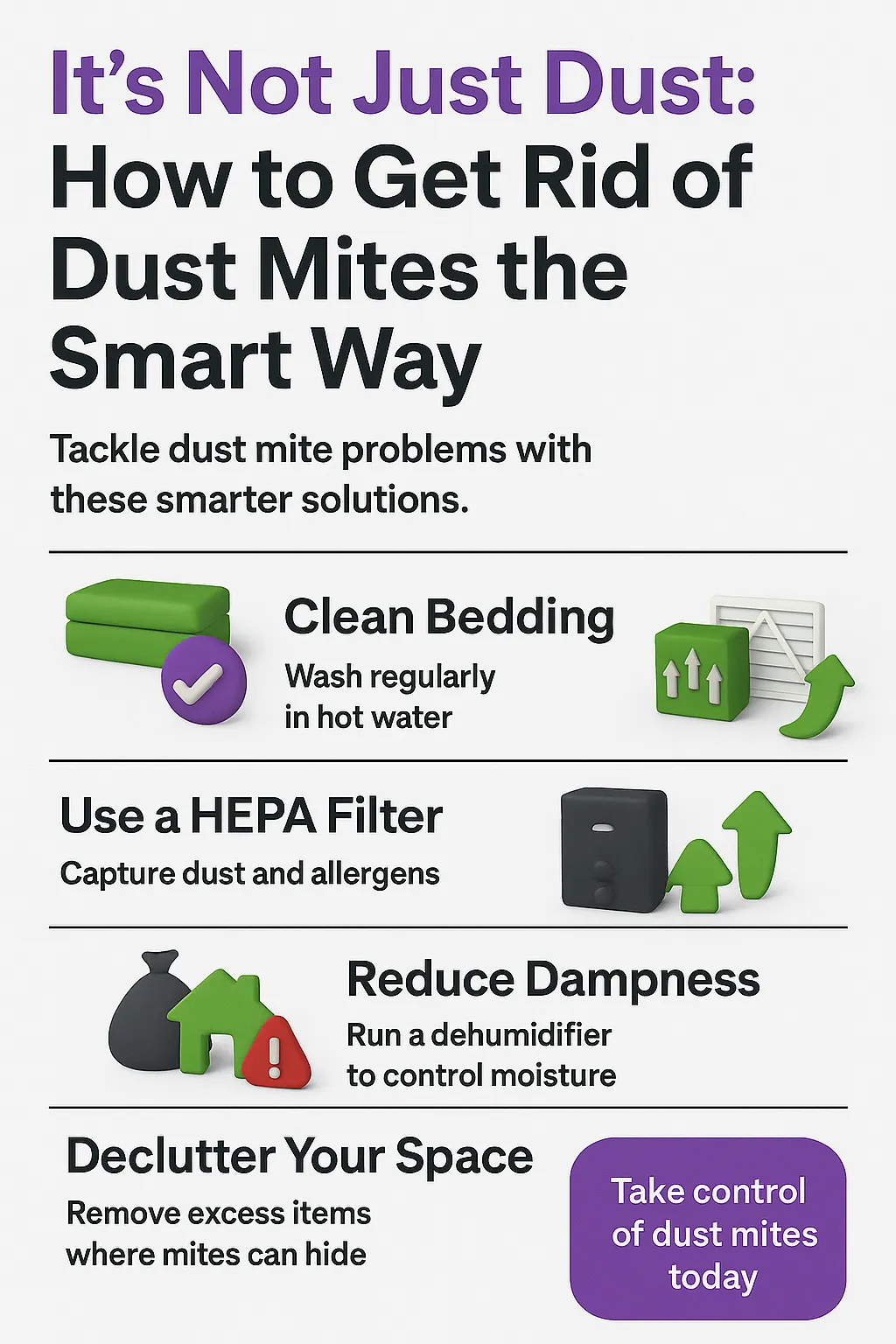If you’re constantly sneezing indoors or waking up congested, don’t just blame the dust on your shelves. The real issue might be microscopic—dust mites. These invisible pests thrive in soft furnishings and humid environments, triggering allergies and asthma without ever being seen. In this article, I’ll share a smart, tested approach to how to get rid of dust mites—not with fads, but with practical, science-backed methods that worked for me.
Top Takeaways
- Dust mites exist in over 80% of U.S. homes, especially in mattresses and carpets.
- High humidity promotes dust mite growth—keep it below 50%.
- Smart prevention requires layered solutions: wash, seal, vacuum, and dry.
- Relief often begins within a few days of consistent effort.
- Long-term improvement means building sustainable habits.
A Smarter Way to Eliminate Dust Mites
Dust mites feed on skin flakes and thrive in warm, moist environments. You can’t see them—but you can feel their effects. The good news? You don’t need expensive gadgets or miracle sprays. You need a system.
Focus on high-risk zones first
- Wash all bedding in hot water (at least 130°F) once a week
- Use dust mite-proof covers on pillows and mattresses
Go deeper than the surface
- Vacuum carpets, rugs, and upholstered furniture with a sealed HEPA vacuum
- Don’t forget overlooked areas like curtains and stuffed animals
Dry the air
- Run a dehumidifier to maintain indoor humidity below 50%
- Use a hygrometer to track moisture levels in real time
Filter the air smartly
- Upgrade to MERV 11 or MERV 13 HVAC filters
- Place HEPA air purifiers in high-use rooms
Quote From Personal Experience
“I thought I had a clean home—until I started focusing on what I couldn’t see. Using sealed covers, better filters, and controlling humidity transformed the way I felt indoors.”

Case Study: When Strategy Beats Surface Cleaning
My Results After 10 Days
I suffered from year-round allergy symptoms. When I finally followed a smart, structured plan, everything changed:
- Sealed my bed and pillows with allergen-proof covers
- Washed bedding in high heat twice a week
- Swapped in a MERV 13 filter for my central air system
- Used a dehumidifier to maintain 45–50% indoor humidity
Within days, I could breathe easier and sleep better. My symptoms reduced drastically.
Family Example: Whole-Home Clean Air Game Plan
A family in Atlanta with two allergic children took a full-house approach:
- Replaced bedroom carpets with hard flooring
- Washed toys and curtains weekly
- Used HEPA air purifiers and a sealed vacuum
- Installed a whole-home dehumidifier
After a few weeks, the kids needed fewer allergy medications and were sleeping through the night.
Why It Works
These strategies aren’t random—they follow expert guidance from the EPA and NIH. It’s a smart, systematic method, not a one-time fix.
Research You Can Trust
- 80% of U.S. homes harbor dust mites, mostly in bedding and upholstered items
- As little as 2 µg of allergen per gram of dust can trigger allergic reactions
- Indoor humidity above 50% increases respiratory risk by 30–70%
My Final Opinion: Be Consistent, Not Complicated
Dust mites aren’t your fault—but ignoring them is a mistake. I learned that smart changes beat constant frustration. You don’t need to eliminate every speck of dust—just make your environment less welcoming to allergens.
What worked for me:
- Weekly hot washes
- Sealed bedding
- Humidity control
- HEPA-level filtration
- Real-time air tracking
Key takeaway: Smart air management beats short-term cleaning. Incorporating air purifying plants into your routine makes it even more effective, and your body will thank you.
Next Steps: Dust Mite Defense Made Easy
- Wash bedding in hot water (130°F+) weekly
- Use allergen-proof mattress and pillow covers
- Keep humidity below 50% with a dehumidifier
- Monitor moisture with a hygrometer
- Vacuum with a sealed HEPA filter vacuum
- Install a MERV 11 or MERV 13 HVAC filter
- Place HEPA air purifiers in sleeping areas
- Clean soft surfaces like curtains and plush toys regularly
- Track your air quality monthly and adjust as needed
Smart Tip: Set a weekly cleaning schedule and make dust mite control automatic—not stressful.
Frequently Asked Questions
What’s the best way to get rid of dust mites?
Use a smart, multi-step approach: wash bedding, reduce humidity, use allergen covers, and filter air with HEPA or MERV-rated systems.
Can dust mites be completely removed?
No, but you can significantly reduce their numbers and their impact with consistent efforts.
What kills dust mites naturally?
Hot water, steam cleaning, sunlight, and essential oils like eucalyptus are natural solutions. Dry air also helps prevent their growth.
Where do dust mites hide most?
Mattresses, pillows, couches, rugs, curtains, and stuffed animals.
Do air purifiers help?
HEPA air purifiers help remove airborne mite allergens. Use them alongside humidity control and cleaning for best results.
To truly address the problem outlined in "It’s Not Just Dust: How to Get Rid of Dust Mites the Smart Way," using the right tools and strategies is essential. One of the most effective steps is upgrading your air filtration system with high-quality filters like the 17.5x23.5x1 Pleated Furnace Filters, which trap dust mites and allergens before they circulate in your home. For households seeking maximum filtration, the 20x20x4 MERV 13 Pleated HVAC AC Furnace Air Filters (5-Pack) offer superior performance in capturing even the smallest particles. Budget-conscious buyers can also find reliable filter options such as those listed on eBay to help maintain cleaner indoor air. And while improving air quality is the priority, lifestyle choices matter too—enjoying a glass of red wine, as explored in Exploring the World of Wine: From Health Benefits to Top Ratings, may complement a holistic approach to wellness. Similarly, indulging occasionally in sweet varietals like those in Discover the Best Sweet French Wine Varieties can be part of a balanced lifestyle—because a healthy home environment pairs well with healthy, mindful living.



